#gymnosperms
Text
Naked Sperm Plants
Gymnosperms are weird.
The thing all gymnosperms have in common, and that separates them from their much more successful rival cousin group the angiosperms (flowering plants) is that they have seeds without a seed coat. That’s literally what "gymnosperm" means.
Sperm means "seed" or whatever. And the Greek root gymn- means "naked". Because in ancient Greece the gymnasium was a place where manly men would go to work out, make gains, be naked, wrestle, hang out with the boys and appreciate each other’s gains. While naked. Together. Y’know… Man stuff. For men.
Gymnosperms include pine trees, cycads (which look like giant half-buried pineapples with a single giant pinecone/flower thing coming out the top), gnetums (look like normal leafy plant vines), ephedras (weird stick shrubs with no leaves), the welwitschia(an immortal desert plant that grows exactly two blade leaves endlessly until it’s just a tangled pile of leaf), and the gingko (a single species of tree that paradoxically hasn't gone extinct for 299million years despite being completely unadapted to any existing ecosystem and also makes vomit "berries") So you see, all the Gymnosperms are freaking weird.
I mentioned ginkgo “berries” in scare quotes because these aren’t actually berries. They’re not even fruits. It’s actually just the seed but with a fruit-like fleshy seed coat bit around it. Remember how I said that gymnosperms by definition don’t have seed coats? Yeah, the ginkgo has one of those despite being a gymnosperm; taxonomy is a folly of man’s hubris.
31 notes
·
View notes
Text

Eastern red cedar ornament, 2023
41 notes
·
View notes
Text
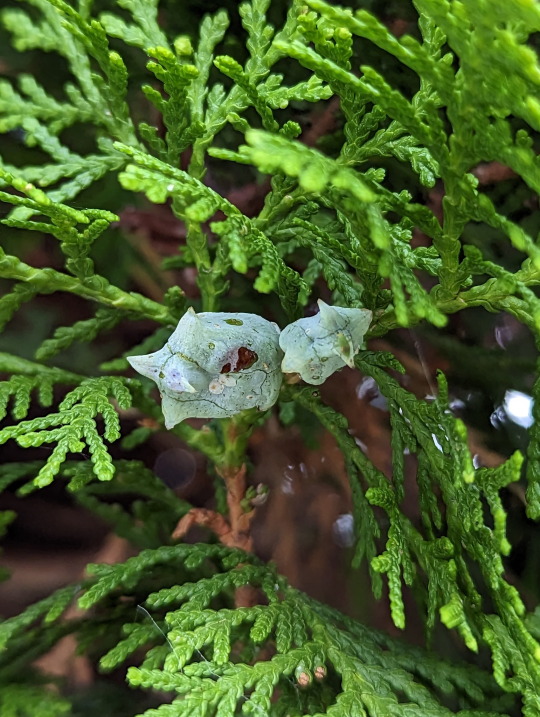



Cypress Cones
Platycladus orientalis
20/03/23 - NSW
#Platycladus orientalis#pine cones#botany#Chinese Arborvitae#Cupressaceae#Cypress#Conifers#Pinopsida#gymnosperms#Tracheophyta#Vascular Plants#Plantae#Plants#pine
42 notes
·
View notes
Text
Mod 3: Gymnosperms
Pinus Needle T.S.
It is circular in outline in P. monophylla, semicircular in P. sylvestris and triangular in P. longifolia, P. roxburghii, etc.
Outermost layer is epidermis, which consists of thick-walled cells. It is covered by a very strong cuticle.
Many sunken stomata are present on the epidermis.
Each stomata opens internally into a substomatal cavity and externally into a respiratory cavity or vestibule.
Below the epidermis are present a few layers of thick-walled sclerenchymatous hypodermis. It is well developed at ridges
In between the hypodermis and endodermis is present the mesophyll tissue.
Cells of the mesophyll are polygonal and filled with chloroplasts. Many peg-like infoldings of cellulose also arise from the inner side of the wall of mesophyll cells.
Few resin canals are present in the mesophyll, adjoining the hypodermis. Their number is variable but generally they are two in number.
Endodermis is single-layered with barrel-shaped cells and clear casparian strips.
Pericycle is multilayered and consists of mainly parenchymatous cells and some sclerenchymatous cells forming T-shaped girder, which separates two vascular bundles. Transfusion tissue consists of tracheidial cells.
Two conjoint and collateral vascular bundles are present in the center. These are closed but cambium may also be present in the sections passing through the base of the needle.
Xylem lies towards the angular side and the phloem towards the convex side of the needle.
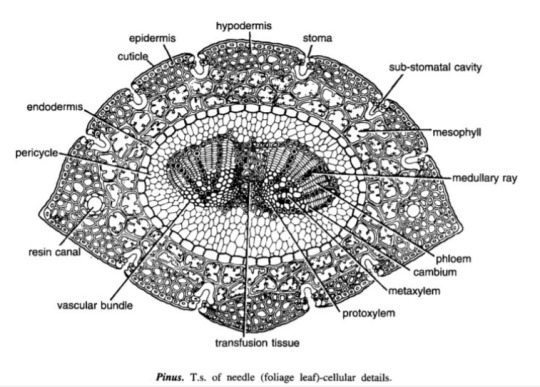
Idk where to find xeric nature info
Williamsoniaceae
Occurrence of Williamsonia
Williamsonia belongs to family Williamsoniaceae of Bennettiales.
It has been reported from Upper Triassic period but was more abundant in Jurassic.
This was earlier discovered under the name Zamia gigas by Willamson in 1870 but has now been named as Williamsonia.
Professor Birbal Sanhi (1932) described W. sewardiana from Rajmahal Hills of Bihar (India).
External Features of Williamsonia
Williamsonia resembled Cycas in appearance, but its best-knows species is W. sewardiana. The plant had an upright, branched, and stout stem covered by persistent leaf bases.
A terminal crown of pinnately compound leaves was present. For the stem genus Bucklandia, Sharma (1991) opined that features of leaf bases such as their shape, size and arrangement pattern are of taxonomic significance.
He observed that leaves in Williamsoniaceae show syndetocheilic stomata with rachis possessing collateral endarch vascular bundles.

Reproduction in Williamsonia
The fructifications of Williamsonia were large and attained a diameter of about 12 cm.
They were borne on a peduncle.
Many spirally arranged bracts were present around the base of the floral axis.
In W. gigas the cones were present among the crown of leaf bases while in W. sewardinia they were present on the short lateral branches.
Williamsonia plants were unisexual.
Female Flower
The female 'cones' of W. gigas and W. sewardiana have been investigated in detail. Instead of 'strobili' or 'cones', Sporne (1965) proposed to use the term 'flower'.
The conical receptacle was surrounded by many perianth-like bracts. The ovules were stalked.
The apex of the receptacle was naked and sterile. The nucellus was surrounded by a single vascularize integument, which was fused with the nucellus. The nucellus had a well-marked beak and a pollen chamber. In young ovules the micropylar canal was long and narrow.
In mature ovules, the canal widened because of the formation of nucellar plug and disappearance of interlocking cells. In the apical part of the endosperm, Sharma (1979) observed 2 or more archegonia.

Male Flower
Male flowers consisted of a whorl of microsporophyll's which were united to form a more or less cuplike structure. In majority of the investigates species the sporophylls were un-branched but in some species they were also pinnately branched.
Sitholey and Bose discovered W. santalensis from Upper Gondwana, and observed that microsporophyll's in the species were bifid.
One of the branches of microsporophyll was fertile while the other was sterile. The fertile part has finger-like structures called synangia. Each synangium had two rows of chambers enclosing microsporangia.
The fertile branch of the bifid sporophyll possessed many purse-like capsules, in each of which there were present many monocolpate pollen grains.

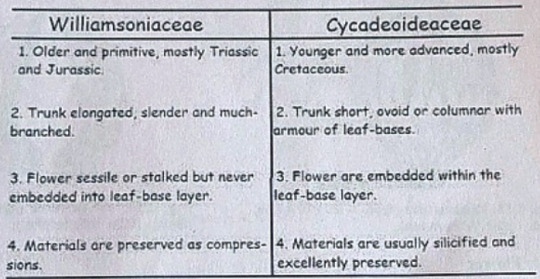
Cycadeoideaceae
Classification:
Division - Cycadeoidophyta
Order - Cycadeoideales
Family - Cycadeoideaceae
Genus - Cycadeoidea
Introduction:
Cycadeoidea is the only genus of family Cycadeoidaceae, represented by thirty species. They are entirely extinct and resemble cycads in the outward stumpy appearance of trunk and an apical crown of pinnate compound leaves. This fossil group of plants flourished during the Triassic to Cretaceous periods of the Mesozoic era. They are reported from various places in the world, in India the Cycadeoidales are found in Rajmahal Hills in Bihar. The petrified trunks of C. entrusca are the oldest fossil ever collected by man.
External Features:
The genus Cycadeoidea had a short, branched, or unbranched spherical, conical, or irregular trunk. The diameter of the trunk is 50cm and the highest rarely reached a meter except in C. jenneyana, it attended the height of several meters. These trunks are covered by rhomboidal leaf bases having multicellular hairs in between. Crown of 10ft long pinnate compound leaves are present at the top.
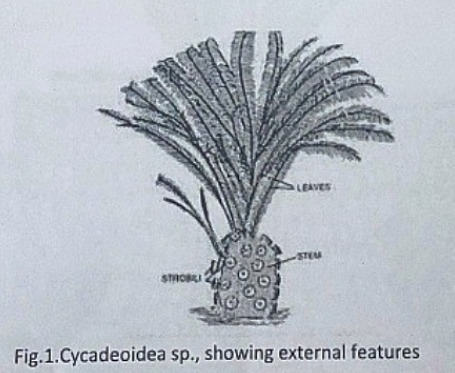
Anatomy of Stem:
The transverse section of the stem shows roughly a circular outline. The epidermis is not very distinct due to the presence of heavy armor of leaf bases. The cortex is parenchymatous and traversed by mucilage canals and numerous leaf traces. The primary vascular structure consists of a ring of endarch, collateral, conjoint, and open vascular bundles encircling the pith. Pith is wide and parenchymatous. A ray-like extension passes between the vascular bundles that make their appearance discrete.
There is a cambium ring with a thin zone of secondary wood. The secondary wood encircles the primary xylem and consists of tracheids with scalariform and bordered pits. The secondary medullary rays traverse the secondary xylem and secondary phloem.
The C-shaped leaf traces arise singly from the primary vascular strand and entering the cortex divided into several masarch strands and enters straight into the leaf.
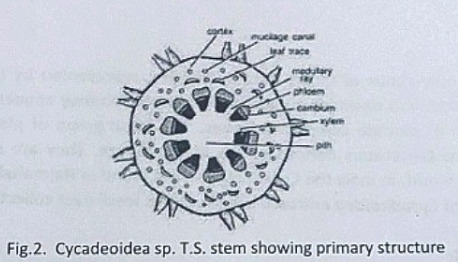
Anatomy of Leaf:
The pinnules show xerophilous structure. The upper and lower epidermis is heavily cutinized and thick walled. The mesophyll cells are distinguished into palisade and spongy parenchyma. The vascular bundles are mesarch and surrounded by bundle sheath.
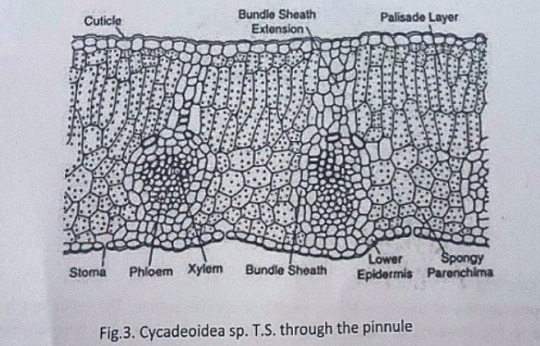
Reproduction:
The reproductive structure is represented by flowers. In most of the species, the flowers are bisexual and arise in the axil of each leaf.
Structure of Flower:
The flowers are bisporangiate, stalked, and partially sunken in the leaf base armor. Rach such mature flower is 5-10cm in diameter and 10cm long. From the base of such flowers about 100 to 150 hairy bracts arise in close spiral little below the apex. These bracts formed a perianth like structure and protect the megasporangiate and microsporangiate parts of a flower. The microsporophyll or androecium forms a whorl united at the base into a sheath. The megasporophyll or gynaecium consists of numerous stalked ovules born around a central receptacle. Between the ovules, interseminal scales with expanded tips are present. These expanded tips fused to form a continuous surface with pores, through which the micropyle of ovules extended. The vascular supply of flowers consists of many branches from leaf traces.
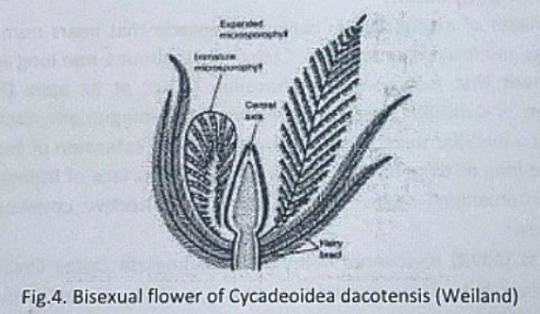
Microsporophyll or Androecium:
The microsporophyll is 10-12cm long, consists of a central rachis bearing numerous pinnae. The pinnae bear two rows of bean-shaped shortly stalked pollen capsules or synangia. These pollen capsules are born on the trabeculae within the fertile region of microsporophyll. A line of dehiscence is also visible at the base of each microsporophyll. This suggest that the entire microsporophyll might have been shed as a unit. The pollen capsule or synangia measures about 3.5x2.5mm and its wall is several layers thick, the outer layer made up of palisade like cells, and the inner layer is made up of thin-walled cells followed by a tapetum. The tapetum was not demarcated. A ring of microsporangia arranged around the periphery of each synangium. The microsporangia dehisce longitudinally and release the microspores into the synangial cavity. At maturity, the synangia liberate these microspores outside by an apical opening that splits into two valves. The liberated microspores or pollens are oval, measures up to 68µ that represents the male gametophytes. Pollen grains of Cycadeoidea are multicellular.
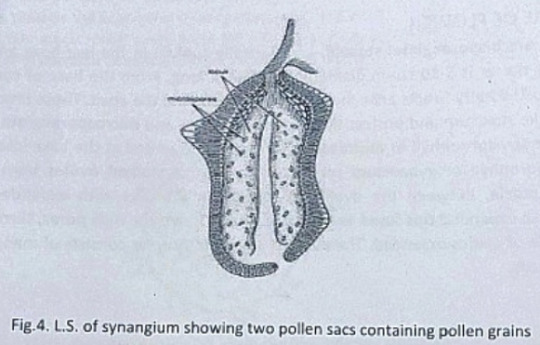
Megasporophyll or Gynoecium
The gynoecium consists of a spherical or conical receptacle that bears numerous stalked orthotropous ovules and interseminal scales. Each ovule is about 1mm long and consists of the single integument that fused with the nucellus except at its apex.
According to Lignier, in C. morieri, nucellus is free from the integument. Each ovule has a pollen chamber and a nucellar beak. This nucellar beak is the extension of the integument. The ovules also have long micropyle, extended from the flat surface of interseminal scales. The fused tips of interseminal scales form an external protective covering or pericarp surrounding the seeds.
Crepet and Delevoryas discovered many of bisporangiate cones from the Cretaceous of black hills. They studied the structure of these ovules in detail. These ovules are urn-shaped and resemble with the ovules of C. wellsii. According to them the micropyle of these ovules are funnel-shaped due to the constriction below the flaring. The inner wall of the micropyle is lined with large cells, considered to be epidermal cells. The integument has three distinct layers. The outer fleshy layer of radially elongated cells, the middle stony layer made up of thick-walled cells, and the inner layer is fleshy.
The young nucellus is made up of thin-walled cells. The cells at the micropylar end are much elongated (80µ long) in comparison to the cells of the chalazal end. The cell at the nucellar tip is pointed up tp whereas cells on either side are bend outward to give the nucellus a distinct shape.
Crepet and Delevoryas reported a linear tetrad or row of three cells in the center of the nucellus.
The seeds are somewhat elongated or oval and possessed two cotyledons.

#exam season#send help#biology#notes#science#botany#gymnosperms#pines#pine trees#pine needles#plants#plant science#plant biology#nature#long post
8 notes
·
View notes
Text
Have to say, of late I have gained a new appreciation for the humble Douglas Fir. Asides its role as one of the most prominent species of Christmas Tree, and by extension collective Christmas memories, the tree is one of those that could live for centuries and tower among the giant Sequoias and Redwoods if given enough time, with some definite 'Deep Woods' or Eldritch potential. Furthermore it is non-toxic and has traditions of being made into various teas.
If you factor in the potential life span of the tree-getting one of the Christmas Trees you can plant afterwards is in some ways like adopting a baby Eldritch Entity at Christmas.
Imagine if while going into the forest at Christmas in order to cut down a tree you get lost and find yourself stumbling further and further in. Watching as the trees continue to slowly get bigger and bigger irregardless of which direction you walk in, all the while snow continues to fall softly. The canopies of the trees get thicker, blocking most of the natural light and making your surroundings get darker as you go. The roots trap soil between them forming natural stairways down steep slopes. Eventually you spot a small light, (is that a light?), in the distance. Still trudging forth to see a small cottage carved out of the centre of a still living Douglas fir. An old decrepit but cheerful woman comes out saying that she had missed you and invites you inside for a cup of tea. She was sweeping the steps with a broom made out of the branches of a Douglas Fir. Not knowing how else to respond you head in. She fusses over you like family and insists you take your coat off to let it dry. You sit at her table. All the furniture is made out of the carved wood of the Douglas fir with still green bows growing out in various places to act as soft furnishings. Then she hands you a steaming cup of tea that smells strongly of citrus and mint. You look down to see it is made out of Douglass fir needles and hot melted snow. As you drink it she talks to you, and you listen. Although you can't remember anything of what she says. When you are finished she hands you back your coat, now dry and warm. Her skin is rough like the bark of a tree. She tells you to take care of yourself and that you must come back to visit some time. You then leave, only to find yourself standing in the parking lot not far from your car, axe still in hand, having still not found a Christmas tree. But tucked underneath your coat you find a small Douglas Fir sapling. You then head home.
Please Note: The sudden onset of warmth can be a sign of hypothermia. Always dress warmly when going outside during winter in below zero temperatures and do not remove any articles of clothing unless they get soaked in water. Stay safe out there.
#douglas fir#deep woods#Christmas Trees#Yule Tree#Tannembaum#Winter#Conniferous#Gymnosperms#Pseudotsuga menziesii
2 notes
·
View notes
Text
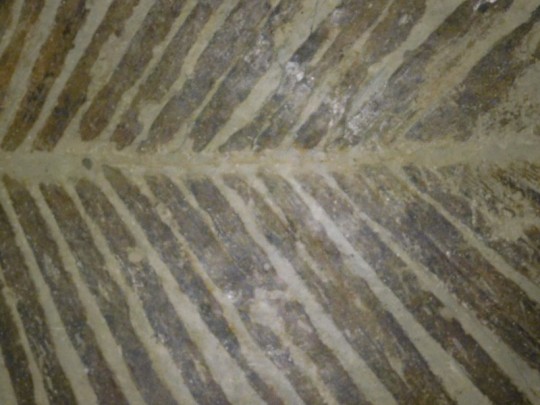
Gymnosperm
#gymnosperms#Plant Fossil#museum of natural history#balboa park#san diego county#San Diego#california#photo#digital#original photographers
2 notes
·
View notes
Photo


Finished up the gymnosperms in my plant bio class!
1: Sugar and coulter pine cones/megastrobili from out west
2: Voyage to Namibia with the one, the only Welwitschia mirabilis. It's a weird ancient plant with two leaves that just keep growing indefinitely as it hangs out in the desert for ~2000 years.
14 notes
·
View notes
Photo
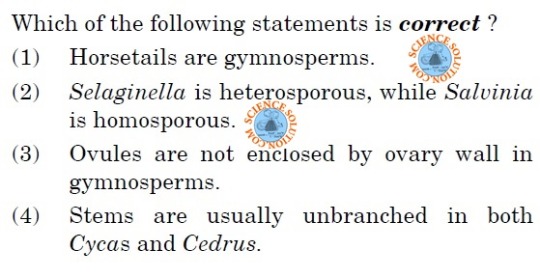
#horsetails#gymnosperms#selaginella#heterosporous#salvinia#homosporous#ovules#ovary#stems#cycas#cedrus#science#solutions
3 notes
·
View notes
Text

#completely arbortrary#podcast#of the trees#listen#plants#water#energy#arboriculture#arborist#angiosperms#gymnosperms#spring#back to life
10 notes
·
View notes
Text
learning about gametophyte and sporophyte forms in seeded plants and prof was talking about gymnosperms (for context I can't visualize in my head) and he was talking about how the sporophyte creates a spore, it stays in the sporangium, develops into a gametophyte!!! then the gametophyte develops an egg!!!! WHILE STILL INSIDE THE SPOROPHYTE lshdkshksgkwgejd and I was like holy shit this is incredible I wonder what it looks like (I also took an edible before class) and then the next slide HAD A PICTURE SKGEMDHKAHSN i litraly felt like I was in the presence of a celebrity

1 note
·
View note
Text



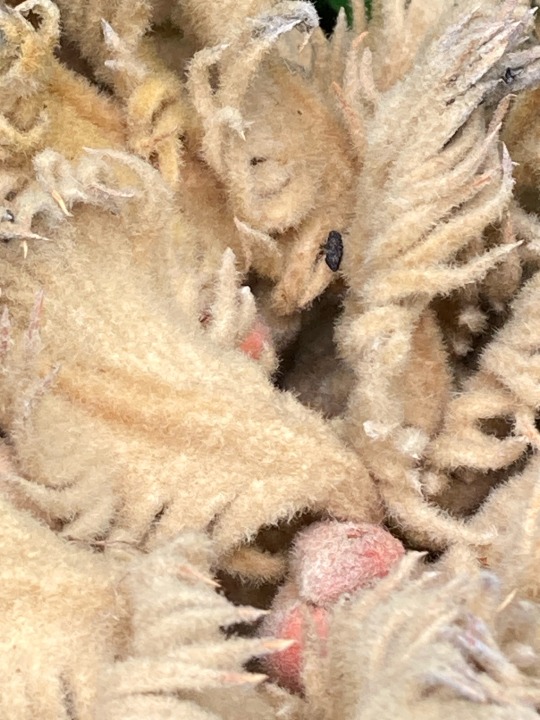


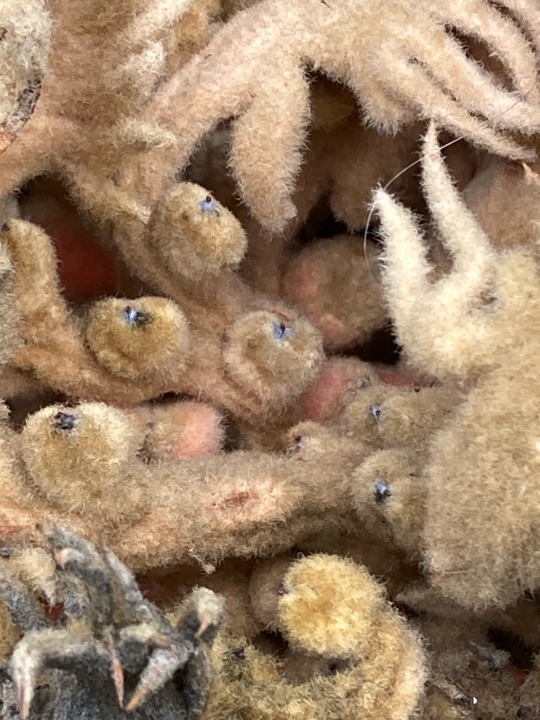
1 note
·
View note
Text
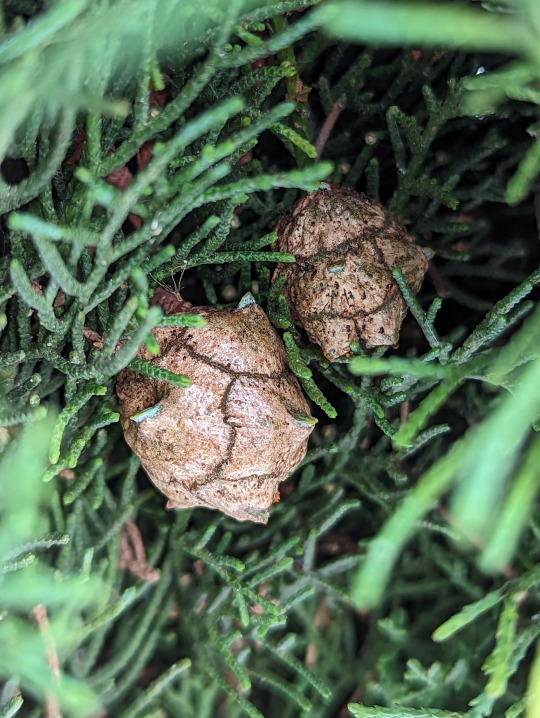
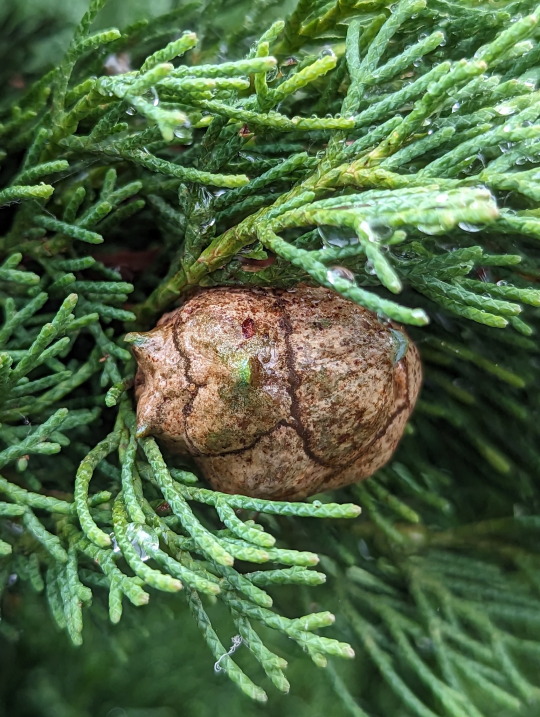


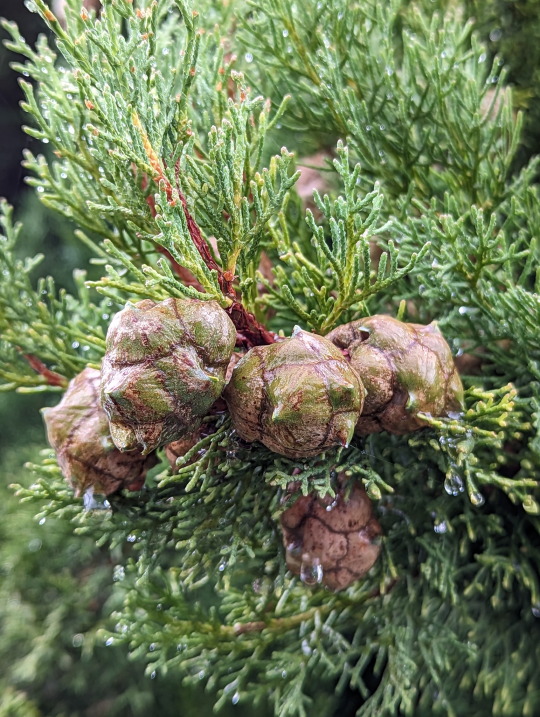
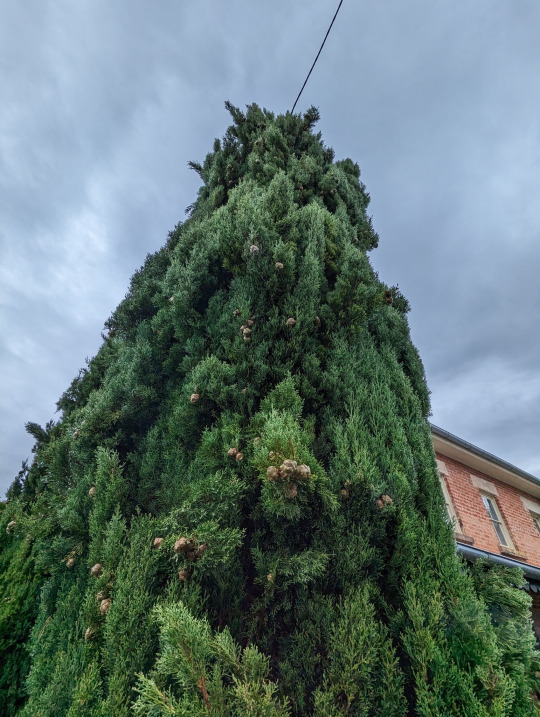
Cypress Tree with Cones
Unidentified, family Cupressaceae
23/03/23 - NSW, Berrima
#Cupressaceae#cypress#cones#cypress cones#Pinopsida#Conifers#Tracheophyta#Vascular Plants#Plantae#Plants#gymnosperms#botany#unidentified
5 notes
·
View notes
Text
Wood's Cycad / Wood-se-broodboom — Encephalartos woodii
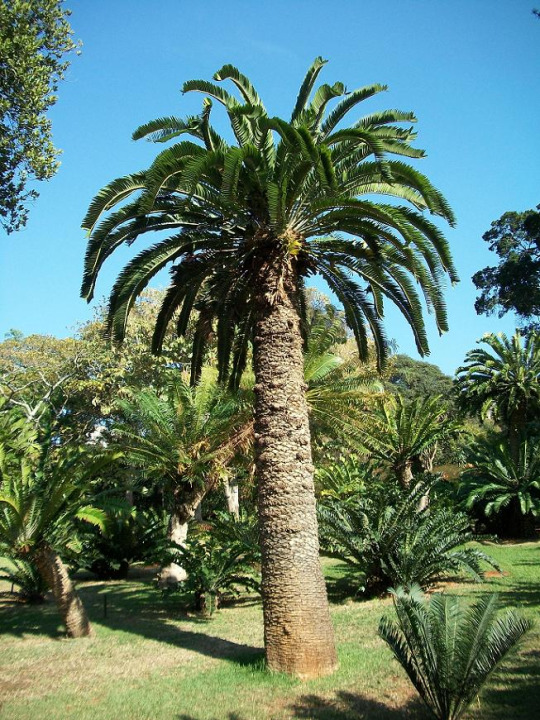
ICUN 3.1 status — EW (Extinct in the wild)
Population: Around 500 (All male clones in collections, institutions, botanical gardens, etc around the world)
Distribution: oNgoye forest, KwaZulu-Natal, South Africa
"Family Tree:"
Family - Zamiaceae
Subfamily - Encephalartoideae
Tribe - Encephalarteae
Subtribe - Encephalartinae
Genus - Encephalartos
Etymology:
Named after John Medley Wood, who discovered(?) it in 1895.
"Broodboom" is an Afrikaans word meaning "bread tree," referring to how the piths ((inside-most)) of the stems would be wrapped in animal skin, fermented, then ground up to make bread with.
Programs:
(Currently looking for these, they do likely exist as there are many endangered cycads and people are working preserve the species)
Cycads are palm-like, slow-growing trees that are reminiscent so many of the sorts of trees that grew around the dinosaurs. Rather they began evolving around 12 million years ago, whereas dinosaurs died off 54 million years ago; yet cycad-like species have been on earth for almost 300 million years. I don't know how to transition into this, but the only Wood's cycad found, in 1895, was a male, as a result all of the existing Wood's cycads in the world are male. Many expeditions for any others in the wild have been fruitless, so they likely will stay this way unless one of the trees somehow changes its gender.
Similarly to the 'Alalā, the Wood's cycad is (likely) one of the rarest species in a very endangered order. Unlike the crow species, this tree is highly sought-after by collectors around the world in an illegal cycad trade business, which causes devastating effects on the population of the already slow-growing plant. Some botanical sites have had to store their cycads behind locked gates so they aren't stolen. When these trees have been taken from their natural environment, this causes a predictable ripple effect within the other organisms in the area — the insects that pollinate cycads die when the cycads leave as they have relied so heavily on them for millions of years for food, reproduction, etc., so bringing them back into the wild causes the trees to die as they don't have pollinators.
Bibliography:
https://en.wikipedia.org/wiki/Encephalartos_woodii
https://www.dimensions.com/element/woods-cycad-encephalartos-woodii
https://pza.sanbi.org/encephalartos-transvenosus
https://news.mongabay.com/2017/05/saving-the-most-endangered-plants-in-the-world/
0 notes
Text
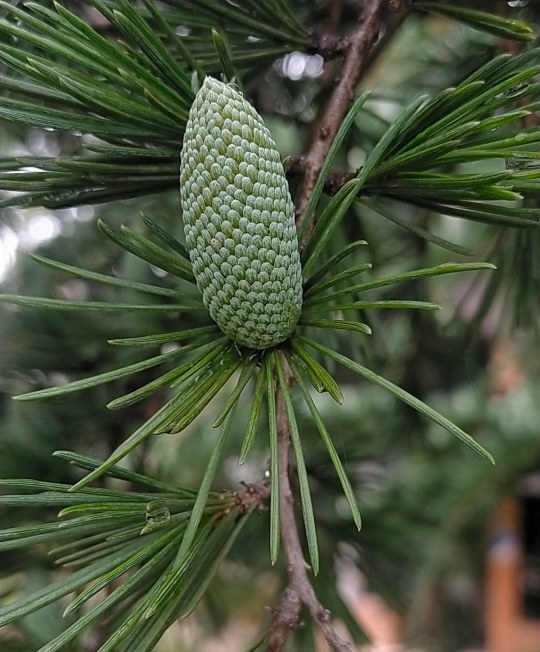
Cedrus sp.
27-MAR-2023
Melbourne, Vic
#australia#victoria#melbourne#pinecone#green#tree#cedar#gymnosperms#pinophyta#pinopsida#pinales#pinaceae#abietoideae#cedrus
0 notes
Text
Cells and genes and human body and life and everything. Translation and replication and mitosis and meiosis and. Origin of the species and survival of the fittest and Darwin and plants and animals and genes and DNA and it all comes back to life and everything.
Yeah, I think I love biology.
#writing#biology#dna#genes#translation#replication#bryophytes#angiosperms#gymnosperms#algae#thallophyta#porifera#cnidarians#darwin#originofthespecies#survival of the fittest
1 note
·
View note
